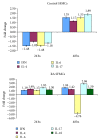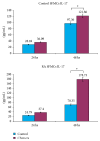Characterization of CD30/CD30L(+) Cells in Peripheral Blood and Synovial Fluid of Patients with Rheumatoid Arthritis
- PMID: 26090498
- PMCID: PMC4452350
- DOI: 10.1155/2015/729654
Characterization of CD30/CD30L(+) Cells in Peripheral Blood and Synovial Fluid of Patients with Rheumatoid Arthritis
Abstract
The CD30/CD30L signalling system has been implicated in the pathogenesis of several autoimmune and inflammatory conditions. In rheumatoid arthritis (RA), soluble CD30 (sCD30) levels reflect the recruitment of CD30(+) T cells into the inflamed joints and correlate with a positive response to immunosuppressive therapy. The aim of our report was to clarify the role of CD30/CD30L signalling system in the pathogenesis of RA. Our analysis of the CD30L(+) T cell subsets in peripheral blood (PB) and synovial fluid (SF) of RA patients and of the related cytokine profiles suggests the involvement of CD30/CD30L signalling in polarization of T cells towards a Th17 phenotype with proinflammatory features. Moreover, in RA SF nearly 50% of Treg cells express CD30, probably as an attempt to downmodulate the ongoing inflammation. We also show here that the engagement of CD30L on neutrophils stimulated with CD30/Fc chimera may play a crucial role in RA inflammation since activated neutrophils release IL-8, thus potentially amplifying the local inflammatory damage. In conclusion, the results obtained suggest that the complex CD30/CD30L signalling pathway is implicated in the pathogenesis and progression of RA synovitis through a concerted action on several immune effector cells.
Figures







References
-
- Agrawal B., Reddish M., Longenecker B. M. CD30 expression on human CD8+ T-cells isolated from peripheral blood lymphocytes of normal donors. Journal of Immunology. 1996;157(8):3229–3234. - PubMed
MeSH terms
Substances
LinkOut - more resources
Full Text Sources
Other Literature Sources
Medical

